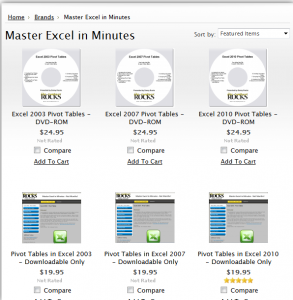 Today, I launched my new online bookstore for The Company Rocks. I am offering my Instructional DVDs for sale individually or as a set at attractive prices. Follow this link to enter the store to learn more about the DVDs in “The 50 Best Tips for …” Series.
Today, I launched my new online bookstore for The Company Rocks. I am offering my Instructional DVDs for sale individually or as a set at attractive prices. Follow this link to enter the store to learn more about the DVDs in “The 50 Best Tips for …” Series.
“The 50 Best Tips for Excel 2007” contains over 5 1/2 hours of training. Each video lesson lasts @ 6 – 7 minutes. Each lesson focuses on one productivity tip. So you can get an answer quickly when you need it. I follow a step-by-step approach to teach you how to be more productive when you use Excel 2007. You can see how to enter and edit the formulas because I use an innovative “pan-in / pan-out” camera technique to focus your attention.
And, as a bonus: The actual spreadsheets that I use for each lesson are included on the DVD!
“The 50 Best Tips for PowerPoint 2007” packs over seven hours of training onto two DVDs! Unlike many instructional packages the teach you PowerPoint from a technical angle, I teach you how to incorporate PowerPoint into your total presentation. I am a professional speaker and trainer. I am not a “techie.” You will learn the technical side of PowerPoint 2007 – but only as it helps you to be more effective in presenting your ideas or products. I think that you will enjoy this difference!
The focus of each DVD is on the Intermediate to Advanced user of Excel or PowerPoint. The focus is on helping you to save time and take advantage of the great presentation elements in both programs. There are 10 videos each at the Beginning Level and at the Advanced Level. There are 30 videos for the Intermediate Level user.
Please visit my new online bookstore to learn more about each DVD. I welcome your feedback!
Thank you for your kind words of support as I have built my business these past three years. I wish you a very happy new year in 2010!
Danny Rocks
danny@thecompanyrocks.com



